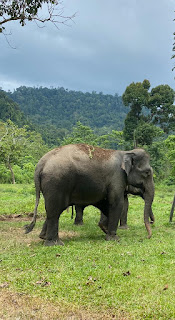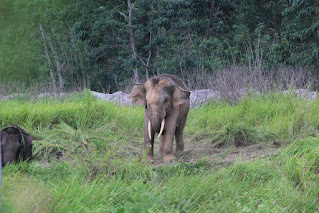Wednesday, August 16, 2023
Elephant In Peusangan Watersheed
Monday, August 7, 2023
Preventive Action: Mitigating Negative Interactions between Elephants and Humans
The interactions between humans and elephants can pose a serious challenge to conservation efforts and the sustainability of elephant populations. Habitat loss, land conversion for agriculture, and rapid human population growth have increasingly reduced the living space for elephants, forcing them to share their territory with humans. As a result, conflicts can arise, potentially endangering both parties. However, as a preventive measure, strategies are needed to mitigate negative interactions between elephants and humans. One crucial action is to raise awareness among communities about the presence and significance of elephants, promoting harmonious coexistence.
Education on safe and appropriate behaviour when encountering elephants, including how to avoid confrontations, is also essential. Additionally, mapping the migration routes and movement patterns of elephants can help in avoiding or anticipating their presence near human settlements. The provision of dedicated corridors or safe migration routes for elephants, connecting protected areas, is also an important preventive step. The use of technology, such as early warning systems with sensors and sound to deter elephants from entering human settlements or agricultural lands, can also reduce the risk of negative interactions. Furthermore, promoting elephant-friendly farming practices, such as using electric fences or natural barriers to protect crops from elephant raids, is an effective preventive measure. The collaboration between governments, local communities, and conservation organizations is of paramount importance. Involving all stakeholders in formulating policies and preventive actions can lead to sustainable and successful solutions in reducing conflicts between elephants and humans. By adopting appropriate preventive actions, we can create a safe environment for both parties, ensure the survival of elephants, and foster harmony between humans and wildlife. These joint efforts will ensure that elephants and humans can peacefully coexist and support each other in preserving the sustainability of our planet.
Sunday, August 6, 2023
Elephant Pocket Habitats: Safe Spaces for Elephant Survival
Amidst urban sprawl and rampant deforestation, the Sumatran elephants have created "pocket habitats" as places of protection and safety for their survival. Pocket habitats are areas that serve as strong refuges for these elephants, where they can live relatively undisturbed and have access to essential resources. Sumatran elephant pocket habitats are natural oases amidst the challenges they face.
These areas may not yet be fully utilized by the elephants but hold great potential as habitats for their populations. These locations are critical to ensure the elephants' survival and development. Within these pocket habitats, elephants can find sufficient food, interact with their group members, and even establish robust social structures. In this protected environment, they can also give birth and raise their offspring without excessive disturbance from human activities or environmental changes.
The significance of Sumatran elephant pocket habitats cannot be underestimated. These protected areas play a crucial role in maintaining the elephant populations' sustainability and preserving the balance of the ecosystems they inhabit. Conservation efforts that focus on restoring and protecting these pocket habitats are vital to safeguard the Sumatran elephants from extinction.
However, challenges abound in preserving these pocket habitats. Human impacts, climate change, and deforestation are significant threats that must be addressed. Collaboration among governments, communities, and conservation organizations is needed to maintain the integrity of these habitats and ensure that elephants have safe and secure spaces to live and thrive. Understanding the importance of pocket habitats for the survival of Sumatran elephants reminds us of our responsibility to protect these vulnerable creatures. Through sustainable conservation efforts and a commitment to the preservation of nature, we can ensure that the Sumatran elephant pocket habitats remain havens of peace and safety for this charismatic species.
Elephants: Sociality and Fission-Fusion Behavior in Asian Elephant Communities
Elephant In Peusangan Watersheed
In the vast expanse of the dense forest within the Peusangan River Basin, lies an invaluable natural treasure. There, amidst the lush foliag...



